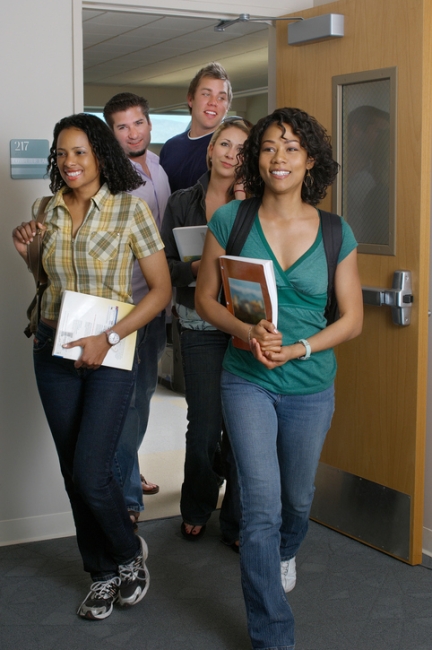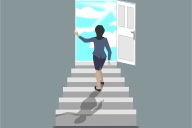You have /5 articles left.
Sign up for a free account or log in.

Istockphoto.com/IPGGutenbergUKLtd
The literature about teaching and learning is pretty clear on this: the first day of class is an important one. No matter the class, whether intro or upper division, the first day should be the time when instructors set the tone for the semester, give a sense of themselves and their approach to the subject, and begin to create a strong community. It is also the perfect time to introduce the main themes of the class.
Over the past 15 years or so, I’ve developed a number of first-day activities that take such issues into account. Just as important, I try to tie activities to the subject matter in some way and get students talking and thinking about topics and skills that will come up over the semester -- so they differ with each class and class level.
I teach art history at a comprehensive university with a mission to serve first-generation, working-class and immigrant students. My students have jobs, families and commutes. All of that is to say that the first step is to know your audience -- in demographic terms, yes, but also in terms of their possible background knowledge.
I especially love teaching the first half of the art history survey, Prehistory to the Middle Ages, since it’s part of our general education curriculum and thus draws students from all over campus. I know that students are taking it for a requirement and that they may have heard that art history is not only boring but also irrelevant. I love the challenge to prove them wrong. The first-day exercise that I’m about to describe is just one of many strategies I’ve developed over the years to draw students in.
The most recent activity I’ve been using in this class is skill based. I know that 10 years from now, students will not remember, for example, the parts of an Egyptian New Kingdom temple. What they are more likely to recall, and use, are the skills of looking that we work on over the course of the semester. So the first day of class -- before we look at the syllabus or talk about course logistics, but after I’ve introduced myself and talked a bit about what I love about ancient art and the intellectual challenge of teaching a general education course -- I ask students to choose a partner. Their first task is to introduce themselves to each other and exchange contact information -- your standard icebreaker, but also, as I point out, a chance to find someone they can study with and get notes from. That’s key in a class that may be 60 to 70 percent commuting students.
After I’ve given them 10 minutes or so to talk, I ask one of the students in each pair to move themselves so that their back is to the screen at the front of the room, with their partner facing it. The person who can see the screen will have the task of describing one of the images they see there to the person who cannot see it, and the listener writes down everything their partner says, from the first word out of their mouth, in order.
The images I show are ones I deliberately pick from those we will discuss during the semester. The preponderance of sculpture in ancient cultures has led me to emphasize the skills of describing and analyzing two- and three-dimensional sculpture in this course, so the images for the first day are sculptures. (I focus on painting in the second half of the survey.) I use two images -- the standard format for comparison in art history, but, in this case, one that sometimes raises preconceived notions that the class will discuss later: whether the condition of a sculpture can tell you anything about its age (not without other contextual information), whether the presence or absence of clothing or accessories indicates the status of the individual depicted (again, needs context), and whether sculptures that look less naturalistic indicate the skill of the sculptor or the primitiveness or earlier date of the culture. Students bring such ideas to my class, even though they usually have never had an art history class before.
What emerges in the students’ discussion, and then again in the larger class discussion after the exercise, are several important things. First, it is difficult to discuss sculpture without a common vocabulary. Second, the common vocabulary students assume they share is not always the same. And, third, translating from a visual image to an oral description is not so easy -- especially without a lot of hand gestures. In order to make this last point stronger, towards the end of the student discussions, I go around the class and check in with various pairs, and suggest that the listening student draw what they think the sculpture looks like based on what they’ve heard. Hasty adjustments ensue after their partner sees the results of their oral description!
In the larger (usually raucous) class discussion that follows the exercise, through the natural flow of conversation, I can introduce the issues I mention above, and vocabulary and concepts that we will use throughout the semester. We can also talk about the importance of what I call critical looking in helping us understand a sculpture more deeply, even without knowing anything about the culture from which it came -- a transferable and useful skill. Because the paper assignment for the course dictates that students go to a museum and write about a work of art, this exercise also underscores the importance I attach to this skill -- one that I emphasize throughout the course by doing small-group exercises in describing specific sculptures from time to time.
The Naïve Task
The reason I’ve stuck with this exercise for several semesters now is that it performs a number of important pedagogical functions. It’s an icebreaker, yes, and it gets students talking to each other and looking at art the first day. Just as important, though, I’ve recently heard it described as what’s known as a "naïve task," according to Kimberly Van Orman, an instructional consultant in the Institute of Teaching, Learning and Academic Leadership at the University at Albany.
Such activities, she said, ask students to attempt disciplinary thinking using only their pre-existing knowledge. Naïveté, Van Orman explained, is a useful stage of learning, great for fostering the kind of curiosity that gets students excited about a discipline. Too often, instructors blow right past it.
Sometimes the first-day activities I design have unexpected consequences. For example, in a class on modern Latin American art this last spring, I designed an activity that introduced one of the overarching questions I have about the subject: Why are Latin American artists so unknown outside the region? I asked students to list as many European and U.S. artists they know and then to list the Latin American ones. The results were predictable: only Frida Kahlo and Diego Rivera came up, versus a raft of names on the European and U.S. side.
What I didn’t anticipate was how struck students were by their own ignorance. Instructors in other classes told me they were talking about it in their classes, as well, and students asked me about it outside of class. They really were engaged from the first day and curious about the subject matter. The exercise was a perfect introduction to the problem-based organization of the course, and the question became their first problem: Why are these artists the only ones they know?
I still use on occasion my very first attempt at designing a first-day activity. In my history of Western architecture course, I have students “build” a building by listing the steps involved, from the foundation to the final structure. (No contractors allowed.) I assign to them in groups of a type of structure, such as an igloo, a bridge and a pyramid, among others. By describing the steps in creating their structure, they come to see some of the main themes of the course: that architecture depends on its site, its function and, in most cases, the materials available to the builders, as well as on construction techniques. Of course, I could just tell them all of this, but grappling with the question of how to build an igloo has a much more vivid and long-lasting effect than a lecture on corbeling.
Developing these kinds of first-day activities depends on thinking long and hard about what you believe your students should most fundamentally take away from your class. What can your discipline help your students see about the world? Especially in general education classes, what do you most want students to remember from their brief brush with it? Foregrounding their previous knowledge and getting them to question preconceived notions in a nonconfrontational and entertaining way has been, in my experience, a way to engender curiosity, if handled gently.
It doesn’t hurt that, after teaching the first half of the art history survey class over 60 times in the last 16 years, I still get excited about ancient cultures and the objects they made. In that time, I’ve realized that I have a large role to play in demonstrating to students why they should care, or be curious, about art of the past. A good part of how I do that is looking for what I call the big ideas but also in thinking about how I teach. Being conscious of that on the first day is the first step.








